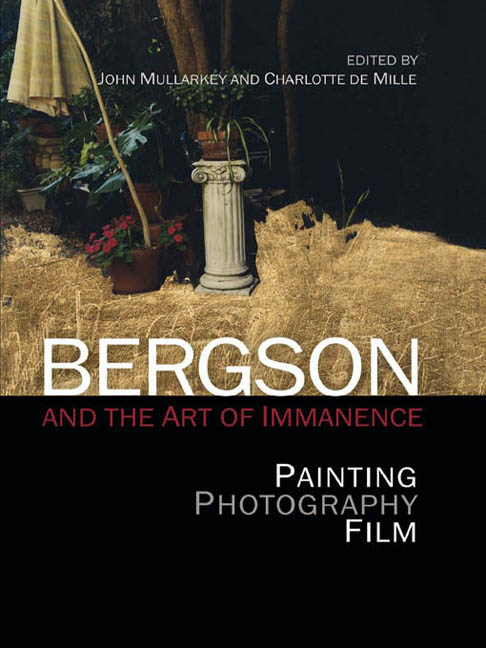Book contents
- Frontmatter
- Contents
- List of Illustrations
- Notes on Contributors
- Introduction: Art's Philosophy – Bergson and Immanence
- Part I Bergson, Art, History
- 1 Bergson, History and Ontology
- 2 Art History, Immanently
- 3 Art History, Less Its Conditions of Possibility: Following Bergson's ‘Le Possible et le réel’
- 4 Matisse, Bergson, Oiticica, etc.
- 5 Bergson Before Deleuze: How to Read Informel Painting
- 6 Revolutionary Immanence: Bergson Among the Anarchists
- Part II Unconditional Practice
- Part III Immanence of the Visible
- Afterword: An Art Historical Return to Bergson
- Index
2 - Art History, Immanently
from Part I - Bergson, Art, History
Published online by Cambridge University Press: 07 December 2017
- Frontmatter
- Contents
- List of Illustrations
- Notes on Contributors
- Introduction: Art's Philosophy – Bergson and Immanence
- Part I Bergson, Art, History
- 1 Bergson, History and Ontology
- 2 Art History, Immanently
- 3 Art History, Less Its Conditions of Possibility: Following Bergson's ‘Le Possible et le réel’
- 4 Matisse, Bergson, Oiticica, etc.
- 5 Bergson Before Deleuze: How to Read Informel Painting
- 6 Revolutionary Immanence: Bergson Among the Anarchists
- Part II Unconditional Practice
- Part III Immanence of the Visible
- Afterword: An Art Historical Return to Bergson
- Index
Summary
Immanent art history cannot be written. Art history concerns selected, condensed particularities, the material objects on which the discipline is founded. Immanence denotes forces and events on a plane that Deleuze in his final essay called simply ‘a life’. Art history is inherently dialectical; recognised and developed by its originators, problematic to their successors. For the last four decades, the socially and culturally motivated ‘new’ art history has archived ‘lives’ for its subjects, often deferring to critical writing that enables it to map its subjects within networks or cultural fields. Such art history has often been hooked into a sequence of theoretical -isms: Marxism, feminism, poststructuralism, postmodernism, staking a claim in an increasingly broad range of media, nibbling at other disciplines, whilst attempting to define itself amid them. More recently, these disciplinary practices have undergone review through a return to subjective histories activated by attention to the temporal unfolding of the art object, led by T. J. Clark's meditation The Sight of Death: An Experiment in Art Writing and W. J. T. Mitchell's provocative What do Pictures Want? Immanence offers virtuality and multiplicity, the possibility of deferring definite meaning even whilst that meaning is being written. The difficulty in immanent writing is that the moment it is on the page – my cursor directing black across a white (‘empty’) surface – it is too late. I fix the content in black figures that cannot be erased or re-shuffled once they have gone to print. But can (the non-verbal art of) painting any more easily suggest the possibility of its making without narrating it? Can we? Re-iterating David Hume's study of relations, Deleuze asks: ‘why, according to civil law, does the ground win out over the surface, but paint over the canvas, whereas paper wins out over writing?’ In each case, material dominates meaning. In these terms painterly abstraction restores meaning to material by rectifying the surface-ground imbalance of representation.
This chapter addresses the question of what the material might show through an analysis of the first known attempt at mechanised painting, Duncan Grant's Abstract Kinetic Collage with Sound, 1914, often known as Abstract Kinetic Scroll (Figure 2.1).
- Type
- Chapter
- Information
- Bergson and the Art of ImmanencePainting, Photography, Film, Performance, pp. 32 - 46Publisher: Edinburgh University PressPrint publication year: 2013

